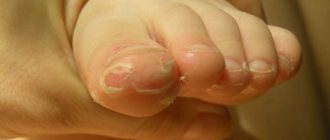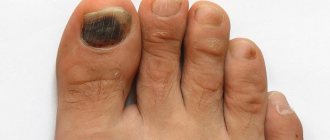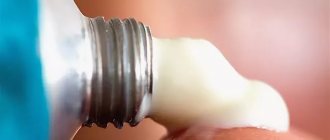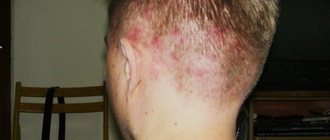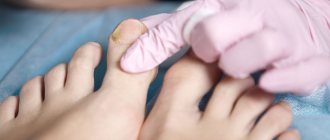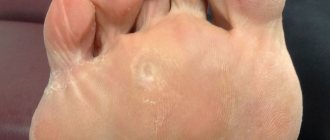There are a number of systemic and local reasons that cause nail detachment on the big toe to develop. If the treatment is chosen correctly and carried out on time, it is possible to avoid complete loss of the nail on the big toe. Independent attempts to treat detachment will lead to a number of undesirable consequences. If you notice the first signs of detachment of the nail plate, it is recommended to immediately visit a dermatologist.
The full course of treatment is usually three months and depends on the individual characteristics of the patient’s body and the stage of the disease. After the treatment, a new plate grows on the nail bed of the toe, and the old one is gradually trimmed. When the nail plate is detached, a number of conservative measures are indicated.
Types of pathology
So, the nail has moved away from the skin. The disease in question is divided into three types:
- The first type of pathology is called kaylonhinia, which is a detachment of the plate in the middle of the nail from the skin.
- Onychoschisis is the medical name for detachment across the growth of the nail plates.
- Onychomadesis is considered the most terrible type of pathology, when nails peel off at the base, which leads to the development of inflammatory processes.
Detachment of the nail plate: causes, symptoms, treatment
One of the common symptoms that patients complain about when visiting a dermatologist is that the nail on the big toe or hand is coming off.
Most often, a doctor is consulted when the defect becomes too noticeable and can no longer be masked with cosmetic varnish. The diagnosis in this case is beyond doubt - onycholysis.
But the causes of this pathology and methods of getting rid of it can be different.
Causes
In 42% of cases, nails on the fingers or toes peel off due to a fungal infection - onychomycosis . You can become infected with it in any public place where there is increased temperature and humidity and it is customary to walk barefoot. This could be a sea or river beach, a swimming pool, a sauna or a shower at a sports club.
With onychomycosis, the nail changes color from yellow to greenish-black, begins to crumble and peel, and becomes dull. In a neglected state, complete rejection of the nail plate from the bed occurs.
Nails can also separate for non-infectious reasons, among which the most common are the following:
- Strong impacts, compression and other mechanical damage. May occur when wearing shoes with very narrow toes or made from synthetic materials that do not allow air to pass through.
- Exposure to chemicals - washing powders, personal care products, creams or varnishes.
- Reaction to acrylic or gel nail extensions.
- Prolonged exposure of hands or feet to water (most often observed among car wash workers, cleaners, and nurses).
- Damage to the nail plate due to inaccurate cutting of its edge with manicure instruments, leading to the appearance of cracks, after which the nail may come off.
- Allergic reactions to certain substances.
- Lack of vitamins in the body, especially A, B and E, as well as iron, magnesium and calcium.
- Fluctuations in hormonal levels, for example, during pregnancy or puberty.
- Long-term treatment with antibacterial drugs.
- Poor circulation of the lower extremities.
In addition, peeling of the nail plates on the hands or feet can be a consequence of the following systemic diseases:
- eczema;
- atopic dermatitis;
- psoriasis;
- bullous dermatosis.
Nails can lag and completely peel off due to chronic diseases of the endocrine, nervous, digestive and cardiovascular systems. In some cases, the falling off of the nail plate is a genetic disease that is inherited.
Symptoms
Most often, onycholysis develops on the legs. Moreover, in most cases the thumb or little finger is affected. However, the symptoms of the disease may vary depending on the causes that provoked it.
If the detachment is caused by a blow or other injury, then the following symptoms are observed:
- bleeding from under the nail plate;
- hematoma formation;
- damage to the skin around the nail;
- pulling and tugging pain;
- change in color (white or bluish-black).
If the nail plate falls off due to a fungal infection, the signs will be slightly different:
- peeling nails on the toes or hands;
- the plates thicken and change color (from dirty yellow to green and black);
- itching and burning begins;
- an unpleasant odor appears;
- There may be a discharge of serous fluid from under the nail.
If the nail comes off due to other reasons, then besides its thickening and partial or complete rejection, there may be no other signs.
Kinds
Depending on the reason that provoked the separation of the nail plate, onycholysis can be:
- traumatic (with mechanical damage);
- systemic (for systemic diseases);
- bacterial (caused by microbial or fungal infection);
- dermatological (appearing after skin pathologies).
In addition, the disease is distinguished by the location of rejection - from the edge of the plate, in the center or at its base. Depending on this, the doctor chooses a treatment method.
Therapy
Before deciding on medications, the doctor must establish the exact reason why the nail began to move away from its bed. Diagnosis is based on a patient interview, visual examination and laboratory test results.
If a bacterial or fungal infection is suspected, a scraping is taken from the surface of the nail plate and sent for microbiological examination and bacterial culture.
In some cases, a dermatologist can give a referral for a biochemical and general blood test and refer you for a consultation with other specialists - an endocrinologist, gastroenterologist, immunologist, cardiologist, neurologist.
The choice of therapeutic technique will depend on the final diagnosis.
Treatment for injuries
Nail plate rejection is very common in children. While running, a small child can fall and injure a finger and nail. If this happens, the following actions should be taken:
- Place the limb under running cold water or apply an ice compress to the injury site for 15-20 minutes. This will help stop the bleeding and relieve pain.
- To prevent the appearance of swelling on the finger around the nail, you need to apply an iodine mesh, and after 30-40 minutes, apply a tight bandage to press the plate as much as possible to the bed.
- If blood has accumulated under the nail, then it is necessary to get rid of it so that inflammation does not start. This procedure must be performed on the child by a doctor in a medical facility. An adult can try to remove the blood clot on their own. To do this, you need to carefully pierce the nail plate with a sterile needle and squeeze out the blood, and treat the puncture site and the skin around the nail with an antiseptic - iodine, brilliant green, hydrogen peroxide, alcohol.
- If the nail begins to tear off after an injury, then the separated part should be cut off with pliers and treated with antiseptics. To avoid infection, apply a soothing and wound-healing ointment (Bepanten, D-Panthenol) to the remaining area and apply a sterile bandage.
- To prevent inflammation from developing under a peeling nail, it is recommended to take sea salt baths (1 teaspoon per liter of water) with a few drops of lavender, rose or tea tree essential oil for 5-7 days.
If the skin around the detached nail begins to swell and become inflamed, you should seek medical attention.
For fungal infections
The nail can split and move away from its bed with advanced onychomycosis. If the doctor confirms this diagnosis, then treatment will consist of the following measures:
- Removal of the nail plate. This can be done surgically under local anesthesia on an outpatient basis or in a modern way using a laser beam. At home, you can use special preparations Nogtivit or Nogtimycin. The product is applied to steamed and dry nails in a thin layer and covered with a band-aid. After a day, the bandage is removed, and the exfoliated part of the nail is cut off with tweezers. The procedure is repeated 4-5 times until the entire nail is removed.
- The use of antifungal ointments and creams - Pimafucin, Exoderil, Zalain, Ketoconazole, Thermicon. If necessary, stronger drugs are prescribed, which include corticosteroids: Akriderm, Triakutan, Triderm, Belosalik.
- If the nail is affected and not completely removed, then medicinal antifungal varnishes can be applied to the remaining part - Oflomil, Demicten or Mikozan, Mikoderil solutions.
- To more effectively get rid of the fungus, systemic oral medications are used. Among them are antimycotics such as Orungamine, Nystatin, Itracon, Itraconazole, Irunin. It is important to know that these drugs should be used only as prescribed by a doctor, since they all have many contraindications and adverse reactions.
Onychomycosis is a disease that is difficult to treat. On average, the course of therapy can last from 2 to 12 months until a new healthy nail grows.
For systemic diseases
It happens that the nail begins to “fall out” for no apparent reason. There was no trauma, the skin on the extremities remains healthy and clean without signs of fungal infection, and the nail plate peels off. In this case, you must make an appointment with a dermatologist and undergo a full examination in order to find out the exact cause of onycholysis and take timely measures.
- If nail rejection occurs due to a lack of vitamins or microelements in the body, then the doctor will prescribe vitamin complexes - Decamivit, Trivit, Duovit, Aevit, Vitrum, Centrum. You need to drink them for at least 6 months until a new nail grows.
- If there are chronic pathologies of the endocrine, digestive, nervous, vascular or other body systems, it is necessary to consult with specialists in these diseases and undergo symptomatic treatment.
- When detachment of the nail plate is a consequence of an allergy, tests should be performed to identify the allergen and completely eliminate its contact with the body.
General recommendations for stopping nail rejection include:
- following a diet that includes foods rich in vitamins and minerals: fruits, vegetables, cottage cheese, cereals, kefir, fish;
- finger massage to stimulate blood movement through the capillaries;
- baths for palms or feet using essential oils of tea tree, cinnamon, rosemary, mint.
To prevent the nail from continuing to peel off, you need to put tight bandages on it, especially at night, when you can unwittingly touch your finger on the bed linen and undermine the nail plate.
Prevention
Onycholysis takes a very long time to treat, so it is important to prevent its symptoms from appearing. To do this, you need to follow some preventive measures:
- Do not wear narrow high-heeled shoes for a long time. From time to time, remove your feet from the shoes and let them “breathe.”
- Do not wear hosiery made from synthetic materials.
- Avoid contact of fingers with aggressive chemicals and use protective gloves.
- Do not stay in a humid environment for a long time, thoroughly dry your feet and hands after water procedures.
- Try to take antibiotics as little as possible.
- Follow the diet and diet, include more foods containing vitamins and other useful substances in the menu.
- Before visiting the sauna, pool or beach, apply antifungal compounds to your feet and toes.
It is also necessary to promptly cure all chronic diseases and undergo regular medical examinations.
Source: https://KozhaInfo.com/raznoe/otsloenie-nogtevoj-plastiny.html
Onycholysis. Description and features of the pathology
When the nail comes away from the skin, it is always extremely painful and very unpleasant; this can lead to inflammation and the process of suppuration. In addition to an infectious disease, the cause may be tight shoes that strongly compress the toes. It is wearing tight shoes that leads to peeling nails in girls. This is especially common among those who constantly wear high heels or running shoes.
In addition, many fashionistas prefer to extend their toenails. This can look quite nice in open shoes. But by wearing closed shoes with such a pedicure, you create an extremely unfavorable environment for the health of your nails, leading to their compression, as a result of which the nails can bend, break and move away from their bed.
Treatments for peeling nails
After eliminating unfavorable factors, if the fingernails move away from the skin, the specialist will determine how to treat the disease and prescribe etiological, pathogenetic and symptomatic therapy. Help consists of using special remedies for nail detachment; they will help you strengthen the plate and prevent the proliferation of pathogenic flora. Use the following options:
- Baths made from herbs or with antiseptic solutions - warm water helps soften and separate the nail plate, improves the penetration of medicinal substances to the affected area. The following solutions have a good effect: 1-2% tinol solution;
- 5% chrysarobin;
- sea salt;
- soda;
- potassium permanganate.
Possible complications
Initially, when the nail comes away from the skin on the hand, there are no symptoms. However, an infection often very quickly enters this space, affecting the soft tissue of the skin on the fingers. As a result, ulcers occur along with inflammation and suppuration. If this disorder is not treated, after some time the nails may fall off the finger. The disease usually develops rapidly, so you shouldn’t wait long. It is very important to begin treatment immediately if the skin under the nail comes off.
If the disease is not cured, then after just six months you may be left without a nail, which will make your fingers extremely unsightly. Often the big toe or toe is affected. True, the infection can spread to other fingers. This disease is typical not only for women, but also for men, who, as a rule, do not attach much importance to it, which leads to serious problems, and, in addition, to the painful course of the pathological process.
Thus, it is very important to contact a dermatologist as quickly as possible, who will require tests and, based on their results, will determine which fungus affects the nail. This will make it possible to prescribe the correct therapy and save your nails.
Directions of treatment
When a nail moves away from the nail bed on the hand, it is necessary to find the cause and a dermatologist will help prescribe competent treatment. The main condition for recovery is the elimination of unfavorable factors that lead to onycholysis. If adverse symptoms are caused by a fungal disease, the patient must receive antifungal drugs.
Purulent processes require consultation with a surgeon to decide whether to remove the damaged area of the plate. If microcirculation in the extremities is impaired, drugs are used to improve local blood circulation. If detachment of the nail from the nail bed occurs due to injury, the influence of chemical factors or certain somatic diseases, then the main direction of treatment is compliance with hygiene measures and careful care of damaged nails.
Attention! The solution to the problem will be provided only by an integrated approach to the treatment of the disease.
Causes
The reasons for the development of the nail coming away from the skin on the finger are, as a rule, the following factors:
- The appearance of fungus and infection.
- Injury to the phalanx, especially the ring finger or thumb.
- The presence of a hereditary or acquired disease.
- Presence of growth problems.
- Improper treatment (self-medication).
- The effect of chemical components or drugs.
- Performing low-quality nail extensions.
Before therapy, you must first completely get rid of the reasons that led to the nail coming away from the skin (pictured). The therapy will be long-term.
Definition of onycholysis, causes and symptoms
In the absence of timely treatment, the process can spread to more than one phalanx. A pathology in which the nail gradually peels off from the nail bed is called onycholysis. If infection enters the damaged area, there is a high risk of complications in the form of inflammation or the appearance of mycoses.
Most often, such changes occur against the background of other conditions. There are reasons why nails move away from the nail plate:
- Treatment with antibiotics.
- Traumatic injuries
- Allergic and autoimmune conditions - atopic dermatitis, eczema, psoriasis.
Pathological disorders do not bother the patient for some time, given the absence of pain. However, a cosmetic defect remains, which is manifested by the following general symptoms:
- the nail lags behind the nail bed on the hands and feet and cannot be treated;
- the appearance of a patch of air under the plate;
- change in color of the skin appendage.
Treatment methods
If the cause is injury, it will be easy to remove this factor. To do this, just carefully cut your nails, watching them until the plate grows to a healthy state. You can stick a special antibacterial patch on your finger during this period. This will make it possible to avoid infection from penetrating under the damaged plate.
If the cause is a disease, you should immediately contact a specialist. When the cause of the disease is chemistry, you should protect your hands from contact with such substances, wearing rubber gloves every time.
General treatment recommendations
At an early stage, treatment is limited to proper hygiene care and prevention of fungal or bacterial infection. To do this, you must adhere to the following recommendations:
- Keep your hands and nails clean regularly.
- Carefully remove excess areas of the stratum corneum using manicure tools.
- After using scissors or other means, thoroughly disinfect them.
- Do not apply polish or other chemical agents until the nail is completely restored.
- If necessary, cover the area of the damaged plate with an adhesive plaster with a bactericidal strip.
- If inflammation occurs, consult a doctor immediately.
Antimycotics
There are so-called antimycotics that can only be taken under medical supervision, as they have many side effects. Treatment is carried out from three months to one year without any interruptions. Antimycotics are presented in the form of Ketoconazole, Griseofulvin, Intraconazole, Fluconazole and Terbinafine.
Every day you need to take baths with salt, and in addition, carry out procedures with potassium permanganate or soda. After such baths, an antifungal cream is applied to the affected area for fifteen days. As the plate grows, it should be carefully cut down. Immediately after removing the affected area, the ointment is rubbed into the nail hole daily for another month. This helps cope with eczema as well as dermatitis.
It is very unpleasant when the nail comes away from the skin. Treatment can be supplemented with traditional methods.
General clinical symptoms
The disease can be suspected if there are signs that bother the patient for a certain amount of time. Patients present the following complaints:
- a disorder in which nails peel off, appears for no apparent reason and is difficult to treat;
- the appearance of areas filled with air where the nails have come off;
- the appearance of inflammation in the form of edema, hyperemia, increased local temperature;
- increasing pain and discomfort at the site of pathology, mainly at night;
- periodic bleeding from under the nail;
- changes occur in the nail bed in the form of gray or yellow spots;
- thickening of the nail plate;
- color change from yellow to blue after injury;
- splitting and brittleness of the nail.
Most cases of nail detachment are caused by fungal diseases. Clinical manifestations persist for a long time and are not amenable to cosmetic correction. If you have nail fungus, many remedies are not effective enough. And treating nails with oils does not reduce pathological symptoms.
Using traditional methods
Treatment can also be carried out using traditional methods, especially if there are any contraindications to treatment with oral antimycotics. For folk therapy, infusions of herbs with olive oil are used. These remedies make it possible to stop the further spread of the fungus. During such procedures, nails grow very quickly, intensively becoming strong and elastic, and they acquire a healthy color. If you monitor and care for your nails, reacting in time to any change in their structure and color, you will always be beautiful and healthy.
Why nails move away from the skin on the hands is now known.
Next, we will learn about methods of preventing this disease.
Classification of nail diseases
We have already looked at the main symptoms. Now we need to clarify what the pathological conditions that lead to onycholysis are called. This is necessary to determine measures to prevent nail plate detachment and therapy. In some cases, the doctor may recommend surgical treatment. The following integrity violations occur:
- Kaylonhinia - changes in the middle part of the nail with the formation of an air bubble or the accumulation of a blood clot;
- Trachyonychia is a disorder of the nail structure that changes the appearance of the plate. There is roughness, dull color, furrows and scales appear.
- Onychomadesis is a pathological process in the base area, which is accompanied by signs of inflammation and severe pain.
- Onychorrhexis is characterized by splitting of the nail in the longitudinal direction due to impaired microcirculation in chronic diseases. In most cases, the nails move away from the nail plate. Treatment is aimed at improving peripheral circulation.
- Onychoschisis is a pathological fragility of the regrown part of the plate. Changes are manifested by transverse detachment due to exposure to chemical, mechanical and infectious factors.
- Hapalochinia - thinning and fragility of the plate. The causes of the pathology are multifactorial in nature.
Prevention
In order to avoid any questions about why the nails move away from the skin, it is necessary to monitor them, carrying out various preventive measures that will certainly help not only prevent the occurrence of the disease, but will also strengthen the nail plates, and at the same time improve the overall health of the nails. the body as a whole. It is necessary to treat not only the hand with creams, but also the nail plates themselves. To avoid certain troubles, you need to make the following recommendations a habit:
- You need to constantly monitor your health.
- You need to carefully choose beauty salons for yourself to perform a manicure, or it is best to acquire your own special tools for this procedure.
- It is necessary to treat not only the hands with creams, but also the nail plates.
- It is imperative to carry out hardening and healing baths. Such procedures significantly help to activate blood circulation.
- It is necessary to treat nails with the help of special nourishing and strengthening agents: serums, medicated varnishes. Then the question of why the nails move away from the skin will not arise.
Such a symptom, when nails move away from the skin, may indicate a deficiency of vitamins and beneficial elements in the body. Thus, to strengthen nails, it is extremely important to take vitamin complexes. Unfortunately, when the nail plate begins to move away from the skin, this can lead to its complete loss. That is why it is extremely important to correctly diagnose the disease, and at the same time select treatment, which, in order to achieve the best effect, should be comprehensive and include medications with folk remedies.
Treatment options
Therapeutic actions are aimed at eliminating the cause of the pathology. The treatment method is selected based on the main problem. First of all, cut off the damaged areas. The procedure is painful and unpleasant, but it is necessary to carry out it.
The skin of the nail bed is treated with ioddicerin. The effectiveness of treatment increases the systemic approach. It is necessary to strengthen the body from the inside. For this purpose, vitamin complexes are taken.
If fungus is present, treatment is carried out using antimicrobial drugs - Exoderil, Nizoral, Lamisil or Nogtivit. Compresses are applied locally from solutions containing alcohol and manganese.
Treatment of fungus takes a long time, sometimes this process stretches for several months. Therefore, it is important to contact a medical specialist as early as possible. Treatment with folk remedies is carried out to suppress the symptoms of the disease.
The following products are most effective:
- Baths with the addition of sea salt accelerate regeneration and reduce the intensity of pain. Preference is given to salt without flavors or dyes.
- Oil masks strengthen the healthy part of the nail and prevent its further separation. Add a few drops of freshly squeezed lemon juice to the oil base. Olive, almond, peach and sunflower oils are suitable for preparing the mask.
- Gelatin baths promote healing of the damaged area on the finger. A tablespoon of gelatin granules is poured into a glass of water and then heated in a microwave oven or using a water bath.
- Treatment with vinegar solution is carried out in cases of mycosis. The procedure is repeated every day.
- Applying aloe leaves to the affected area will have an antibacterial effect and prevent the development of infection.
- Compresses using alum and glycerin are carried out before going to bed. The components are dissolved in a small amount of water. A cotton pad is soaked in the solution and fixed on the finger with a bandage or fingertip.
Wearing gloves if you have problems with the nail plate is prohibited. Humidity and lack of oxygen aggravate existing symptoms.
Preventive actions
When it is clear why the nails move away from the skin, the appropriate conclusions can be drawn. Preventive measures help prevent pathology.
They are as follows:
- It is necessary to take good care of your nails in a timely manner. Mandatory procedures include cleaning from dirt, adding water, trimming and applying nourishing oils.
- After visiting public bodies of water, you should wash your hands thoroughly with antibacterial soap.
- During cleaning, you must protect your hands with rubber gloves.
- Measures to strengthen the immune system help reduce the likelihood of developing various diseases. These include proper nutrition, exercise, hardening and taking vitamin complexes.
- You cannot wear other people's clothing.
- It is advisable to do manicure at home or in trusted salons.
- In case of injuries to the nail plate, you should immediately consult a doctor. It is easier for pathogenic microbes to penetrate through wounds and cracks. This increases the risk of developing an infection.
The photos posted above will help you understand the nature of the origin of the pathology.
Why does the thumbnail come away from the skin?
Onycholysis is a condition in which the nail plate can peel off from its bed. What to do if the nail comes off, for example, on the big toe? How can you correct such a cosmetic defect while maintaining a healthy appearance of your nails for a long time?
Often the nail plate on the big toe comes off as a result of fungal infections. In this case, not only the detachment of the bed occurs, but also the development of inflammatory processes in the skin around the nail itself. If severe, the disease can spread to the interdigital space, the skin of the feet, and in some cases spreads to the lower leg. Only timely treatment of a fungal nail infection will give a chance to avoid spreading infections to other parts of the body.
Often, onycholysis can develop on the big toe. The reasons for this condition lie not simply in infection with a fungus, but also in the frequent infliction of injuries to this area. It is the thumb that gets damaged when falling and bruising on various protruding objects in the premises. Much less often, the nail plates come off on the second and other toes.
The effectiveness of treatment largely depends on the correct diagnosis for the patient. The easiest way to cope with onycholysis, which was caused by injury. If the nail comes off due to a strong blow, it is recommended to carefully remove the damaged part. You can remove the plate using special tools at home. In almost any pharmacy you can always purchase Nogtivit, as well as Nogtimycin or another similar drug, without any problems. Such means allow you to get rid of the affected nail very quickly and quite painlessly, thereby solving the problem of its detachment.
Medicinal methods of therapy
When seeking medical help from a dermatologist, the doctor will first prescribe oral intake of vitamins and medications containing active calcium ions. The substances are considered basic in the structure of the nail plate; their intake will be an indispensable condition for effective treatment. The first appointment of a dermatologist will be the described foot baths with manganese.
Syntomycin emulsion or Tinol alcohol solution is prescribed as antimicrobial and antifungal therapy. The course of treatment directly depends on the severity of the damage to the toenail plate and the general condition of the patient’s body. In a particular case, the duration is determined individually.
Foot massage
To improve blood circulation in the nail bed and accelerate the growth of a new nail plate, a foot massage is used. For a similar reason, physiotherapeutic treatment is prescribed.
If, according to the results of a mycological study, a fungus is identified as the cause of nail damage, the diagnosis becomes the reason for a full-fledged complex treatment. Fungal infections of the toes are extremely difficult to treat and are highly contagious. Do not resort to self-medication, causing further spread of the infection. The fungal infection tends to spread rapidly; within a week it is possible to lose your thumbnail and become infected.
Before a full therapeutic course, the doctor will prescribe tests to determine the nature of the infectious pathogen and sensitivity to specific drugs. Each type of fungus is sensitive to a specific drug; treatment based on tests will be as fast and effective as possible.
If the pathological process has been going on for quite some time and is at an advanced stage, only local treatment with mycocidal drugs is not enough. In these cases, doctors prescribe tablets or capsules for oral administration. Such drugs have an antifungal effect on the body.
Drug treatment
Treatment takes a long period of time, lasting up to a year. However, the effect will definitely be obtained. In extreme and advanced cases, the nail plate is removed through surgery.

